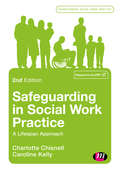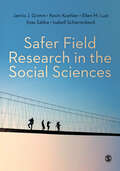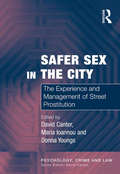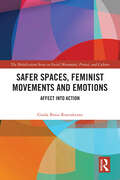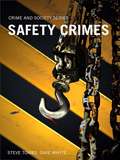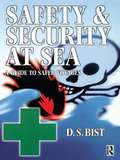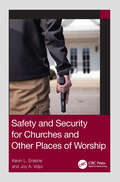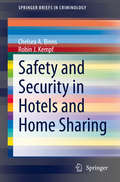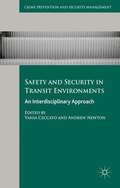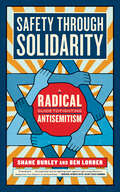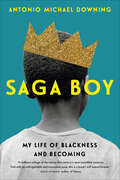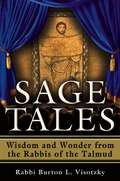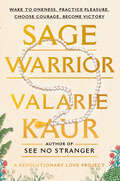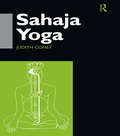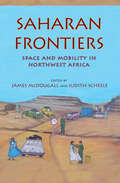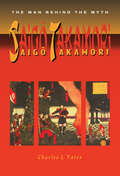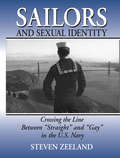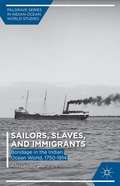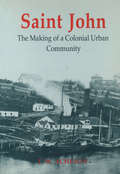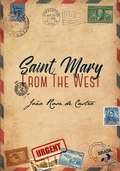- Table View
- List View
Safeguarding in Social Work Practice: A Lifespan Approach (Transforming Social Work Practice Series)
by Charlotte Chisnell Caroline KellySafeguarding is a serious and complex area of social work practice and for all students, demonstrating an understanding of important safeguarding theory, law, policy and skills for practice is essential. Students need to understand what safeguarding is and means across the life course, and this new text brings together common themes and knowledge in safeguarding across children, young people and adult social work to do just that. This approach will encourage students to approach the subject from a holistic perspective, helping them develop their understanding of core themes and transferable skills for practice.
Safeguarding in Social Work Practice: A Lifespan Approach (Transforming Social Work Practice Series)
by Charlotte Chisnell Caroline KellySafeguarding is a serious and complex area of social work, and demonstrating an understanding of important theory, law, policy and skills for practice is essential and it is vital that this understanding extends across the lifespan. This book brings together common safeguarding themes and knowledge across social work with children, young people and adults to help do just that.
Safeguarding in Social Work Practice: A Lifespan Approach (Transforming Social Work Practice Series)
by Charlotte Chisnell Caroline KellySafeguarding is a serious and complex area of social work, and demonstrating an understanding of important theory, law, policy and skills for practice is essential and it is vital that this understanding extends across the lifespan. This book brings together common safeguarding themes and knowledge across social work with children, young people and adults to help do just that.
Safer Field Research in the Social Sciences: A Guide to Human and Digital Security in Hostile Environments
by Isabell Schierenbeck Jannis J. Grimm Kevin Koehler Ilyas Saliba Ellen M. LustExploring the challenges and risks of social science fieldwork, this book shares best practice for conducting research in hostile environments and pragmatic advice to help you make good decisions. Drawing on the authors’ experiences in regions of conflict and grounded in real-world examples, the book: · Provides practical guidance on important considerations like choosing a research question in sensitive contexts · Gives advice on data and digital security to help you minimize fieldwork risk in a contemporary research environment · Offers tools and templates you can use to develop a tailored security framework Building your understanding of the challenges of on-the-ground research, this book empowers you to meet the challenges of your research landscape head on.
Safer Field Research in the Social Sciences: A Guide to Human and Digital Security in Hostile Environments
by Isabell Schierenbeck Jannis J. Grimm Kevin Koehler Ilyas Saliba Ellen M. LustExploring the challenges and risks of social science fieldwork, this book shares best practice for conducting research in hostile environments and pragmatic advice to help you make good decisions. Drawing on the authors’ experiences in regions of conflict and grounded in real-world examples, the book: · Provides practical guidance on important considerations like choosing a research question in sensitive contexts · Gives advice on data and digital security to help you minimize fieldwork risk in a contemporary research environment · Offers tools and templates you can use to develop a tailored security framework Building your understanding of the challenges of on-the-ground research, this book empowers you to meet the challenges of your research landscape head on.
Safer Homes, Stronger Communities: A Handbook for Reconstructing After Natural Disasters
by Priscilla M. Phelps Daniel Pittet Stephen Sena Jennifer Duyne Barenstein Abhas K. JhaBest practices in post-disaster housing and community reconstruction are constantly evolving. The frequency and severity of disasters are increasing and technology is changing how reconstruction is done. Reconstruction projects must increasingly focus on the need to reduce future risks by ensuring that what is rebuilt is safer and more disaster-resilient than what was there before. The expanding role of communities in managing community reconstruction, with financial and technical assistance from government, is another way reconstruction is changing. 'Safer Homes, Stronger Communities' is a handbook that gives policy makers and project managers the information they need to plan and carry out housing and community reconstruction projects that empower communities affected by disasters and that reduce their vulnerability to future disasters. The handbook includes nearly 100 case studies collected from global experts with recent experience in housing reconstruction that illustrate how the policies and practical approaches recommended in the handbook have been used on the ground. It also includes links to extensive technical information on the topics covered by the handbook and is complemented by a Web site for practitioners in the field (http://www.housingreconstruction.org). Designed to provide immediate guidance in post-disaster reconstruction settings, 'Safer Homes, Stronger Communities' is a vital resource for policy makers and project managers, and for all practitioners involved in post-disaster housing and community reconstruction and disaster risk management.
Safer Sex in the City: The Experience and Management of Street Prostitution (Psychology, Crime, And Law Ser.)
by Maria IoannouThroughout history prostitution has always been a source of fierce debate; societies have either grudgingly tolerated it or tried (always unsuccessfully) to ban it. With the emergence of much more overt acceptance of all forms of sexual activity it has become more apparent that sex workers who ply their trade on the streets of our cities are a particularly vulnerable group at risk of violent attacks and assaults. The realization on the implications for such violence on society overall, led to the emergence of this volume. With research gathered from academics and practitioners hailing from various countries and fields, this edited collection will be invaluable for those who want to better understand the experience of street sex workers, the strategies available for managing this trade and how to help reduce the violence against the men and women who conduct it.
Safer Spaces, Feminist Movements and Emotions: Affect into Action (The Mobilization Series on Social Movements, Protest, and Culture)
by Giada Bonu RosenkranzDrawing on participatory action research conducted in Italy and Spain among feminist spaces, this book examines the production of safer spaces and the underlying infrastructure of affect and emotions that shape, enable, and support collective action. Amid the prevailing backlash observed in various European countries, a new wave of feminist movements has emerged since 2015, emphasizing the significance of establishing secure physical spaces within urban settings to counteract the rising levels of inequality, gender-based violence, and economic crises. By challenging a binary understanding of safe spaces, this book presents a dynamic conceptualization of safety within feminist movements, employing an analysis of affect and emotion in collective action. This intricate emotional labor not only challenges traditional gender norms and the social structures that perpetuate them but also poses a critique of the prevailing economic model. Based on four years of ethnographic fieldwork (2017–2021), the argument of the book stems from participants’ involvement in the research process, incorporating constructivist grounded theory methods throughout data collection, concept development, and results dissemination. The book argues that the work on affect and emotions within feminist spaces has transformative effects, by increasing the potential for collective action.As such, it will appeal to scholars of political science and sociology with interests in social movements, gender, and democracy.
Safety Crimes (Crime and Society Series)
by Steve Tombs Dave WhyteEvery year in the UK, hundreds of workers are killed just doing their jobs, thousands more die of illnesses caused by their work and tens of thousands suffer major injuries such as amputations, loss of sight, serious burns, and so on. Worldwide, two million people are killed by work each year. Yet with the exception of high profile cases such as the gas leak at Bhopal, India, which killed tens of thousands, this crime wave fails to attract the interest of the politicians, the media or - least forgiveably of all - the knowledge industry of criminology. This book is concerned with crimes against worker and public safety, providing an account and analysis of this increasingly important field, and setting this within the broader context of corporate and white-collar crime. It uses case studies and original analyses of official data to illustrate key points and themes, drawing upon both well known and high profile instances of safety crimes as well the mass of ubiquitous 'mundane' or 'routine' deaths and injuries. Thus the book examines how much safety crime is there, how are such offences rendered invisible, and how can their extent be unearthed accurately? Throughout the book the authors analyse the social, legal and political processes that ensure that safety crimes remain subject to under-enforcement and under-criminalisation. This analysis identifies key moments in the historical development of criminal law and regulation, and assesses the prospects for criminalising safety crimes in the context of contemporary neo-liberal regulatory policies. The theoretical and political justifications for dominant approaches to the regulation and sanctioning of safety criminals are subject to critique in order to develop alternative, more effective, means of criminalisation and punishment. The book concludes with an original analysis of safety crimes that allows us to understand the complexities of the conditions of their production, and develop a more realistic appraisal of the prospects for their amelioration.
Safety Orange (Forerunners: Ideas First)
by Anna Watkins FisherHow fluorescent orange symbolizes the uneven distribution of safety and risk in the neoliberal United States Safety Orange first emerged in the 1950s as a bureaucratic color standard in technical manuals and federal regulations in the United States. Today it is most visible in the contexts of terror, pandemic, and environmental alarm systems; traffic control; work safety; and mass incarceration. In recent decades, the color has become ubiquitous in American public life—a marker of the extreme poles of state oversight and abandonment, of capitalist excess and dereliction. Its unprecedented saturation encodes the tracking of those bodies, neighborhoods, and infrastructures judged as worthy of care—and those deemed dangerous and expendable. Here, Anna Watkins Fisher uses Safety Orange as an interpretive key for theorizing the uneven distribution of safety and care in twenty-first-century U.S. public life and for pondering what the color tells us about neoliberalism&’s intensifying impact often hiding in plain sight in ordinary and commonplace phenomena. Forerunners: Ideas First is a thought-in-process series of breakthrough digital publications. Written between fresh ideas and finished books, Forerunners draws on scholarly work initiated in notable blogs, social media, conference plenaries, journal articles, and the synergy of academic exchange. This is gray literature publishing: where intense thinking, change, and speculation take place in scholarship.
Safety and Security at Sea
by D S BistSafety and Security at Sea is concerned with the safe operation of ships and consequently with preventing errors and oversights. This book contributes to safety where it is most effective - right at the site of work, on board the ship itself. It is here, indisputably, that it will prevent accidents and save lives. It translates theory into practice besides covering several new and current topics. This book is aimed at every deck officer - at every rank and on all ships. The book also attends to other manifest needs and discusses piracy, stowaways, management of crew on board and several other new and current topics in the interest of safety.All deck officers will find, when preparing for professional examinations, that the area which the oral section of these examinations at any level (Class One, Two or Three) cover - safety - is the one in which this book specialises. It will be an invaluable aid in passing these exams. By discussing essential details in every part of a voyage, parts that form different subjects in the theoretical section, it becomes an excellent reference book for them. In addition, it will also asist the staff of shipping companies in compiling ship operation manuals.This book includes the advice of various notices from the Marine Safety Agency and of guidelines from the International Maritime Organisation. It explains their requirements - International safety management code, emergency pollution control plans and others.In order to deal with ship board work thoroughly, this book takes an entire voyage into account. That is the reason for the sequence of its chapters to correspond to the progress of an actual voyage. The book begins with a ship embarking on a voyage and, in succession, conveys its message in a comfortable language. The last chapter leaves the reader at the beginning of another, but a safer, voyage.A summary is included at the end of each chapter.
Safety and Security for Churches and Other Places of Worship
by Kevin L. Erskine Joy A. VolpiSafety and Security for Churches and Other Places of Worship is a reference book focused on how to form a first responder team for churches, synagogues, temples, and other places of worship. It will assist team leaders on how to train for both security and medical emergencies, provide training aids and ideas, and how to write SOPs and legal issues. Trending violence directed at soft targets is growing, forcing places of worship to respond with highly trained personnel to quickly intervene. Many medical incidents can have drastically better outcomes if trained medical personnel render immediate medical care. For instance, the use of an AED in conjunction with CPR can drastically improve survival rates from 15% to 85%, versus just CPR alone. Topics covered include: Environmental disasters Acts of violence Active shooter incidents Bomb threats Unruly/disruptive persons Suspect control Sexual abuse Realistic training using fake wounds Tabletop exercises Team building Medical emergencies An equipment chapter helps to determine what equipment is a priority for teams limited by budget. Some equipment can mean the difference between a "friend" being mistaken for an aggressor, resulting in an innocent person being injured or killed. Safety and Security for Churches and Other Places of Worship is a must-have reference for anyone charged with the duty to protect those who attend and work at places of worship.
Safety and Security in Hotels and Home Sharing (SpringerBriefs in Criminology)
by Chelsea A. Binns Robin J. KempfThis brief comparatively reviews the security and safety features of hotels and home sharing services. It reviews crime data, laws, and applicable theories – such as defensible space, rational choice, and routine activity theories - to determine how responsibility for crime control and accident prevention in these industries is allotted.This analysis identifies key policy questions about the role of the home sharing hosts and guests in ensuring their own safety and security, which will be of interest to policy makers, researchers and practitioners in criminal justice and law enforcement, as well as those involved in the home sharing and hotel industries.
Safety and Security in Transit Environments
by Vania Ceccato Andrew NewtonSafety and Security in Transit Environments presents important interdisciplinary approaches to safety and security on public transport from leading international authors. The book develops a conceptual framework and demonstrates that transit safety and security is dependent on multi-scale dimensional conditions acting at various geographical scales in the urban environment. These include: the micro-environmental attributes of a node (a stop or station), the characteristics of the immediateenvironment and its wider neighbourhood (the meso and macro transit settings), and the importance of considering all settings encountered in a journey ('door to door') from the perspective of all its users. This important volume identifies key challenges and complexities in addressing security and safety concerns in transit settings, policy recommendations for prevention, and new frontiers for research at transit settings. This book contains one chapter that is available open access under a CC BY license.
Safety through Solidarity: A Radical Guide to Fighting Antisemitism (Activist Citizens' Library)
by Shane Burley Ben LorberTwo activist journalists present a progressive, intersectional approach to the vital question: What can we do about antisemitism?Antisemitism is on the rise today. From synagogue shootings by white nationalists, to right-wing politicians and media figures pushing George Soros conspiracy theories, it&’s clear that exclusionary nationalist movements are growing. By spreading division and fear, they put Jews, along with other marginalized groups and multiracial democracy itself, at risk.And since the outbreak of war in Gaza, debates around antisemitism have become more polarized and high-stakes than ever. How can we stand in solidarity with Palestinians seeking justice, while also avoiding antisemitism — and resisting those who seek to conflate the two? How do we forge the coalitions across communities that we need, in order to overcome the politics of division and fear?Using personal stories, historical deep-dives, front-line reporting, and interviews with leading change-makers, Burley and Lorber help us break the current impasse to understand how antisemitism works, what&’s missing in contemporary debates, and how to build true safety through solidarity, for Jews and all people.
Saga Boy: My Life of Blackness and Becoming
by Antonio Michael DowningA Black immigrant journeys from the Caribbean to Canada—and through multiple musical personas—in a “deeply moving” memoir “suffused with poetic prose” (Publishers Weekly, starred review).As a clever, willful boy in a tiny village in the tropical forests of Trinidad—raised by his indomitable grandmother, Miss Excelly, and her King James Bible—Antonio Michael Downing is steeped in the legacies of his scattered family, the vibrant culture of the island, and the weight of its colonial history. But after Miss Excelly’s death, everything changes. The eleven-year-old seems to fall asleep in the jungle and wake up in a blizzard: he is sent to live with his devoutly evangelical Aunt Joan in rural Canada, where they are the only Black family in a landscape starkly devoid of the warm lushness of his childhood.Isolated and longing for home, Downing begins a decades-long journey to transform himself through music and performance. A reunion with his birth parents, whom he’s known only through story, closes more doors than it opens. Instead, Downing seeks refuge in increasingly extravagant musical personalities: “Mic Dainjah,” a boisterous punk rapper; “Molasses,” a soul crooner; and, finally, an eccentric dystopian-era pop star clad in leather and gold, “John Orpheus.” In his mid-thirties, increasingly addicted to escapism, attention, and sex, Downing realizes he has become a “Saga Boy”—a Trinidadian playboy archetype—like his father and grandfather before him. When his choices land him in a jail cell, Downing must face who he has become.“Lush language and sensory details make the fascinating events of this memoir pop. An authentic, entertaining, and timely account of a creative immigrant’s experiences.” —Booklist“Downing’s elegant, engaging memoir will have particular significance to readers from the Caribbean diaspora, but it will be understood by any reader who has ever had their world suddenly upended and needed to make it whole again.” —Library Journal“A rich memoir about how far some folks have to travel just to arrive where they began.” —Minneapolis Star Tribune
Sage Tales: Wisdom and Wonder from Rabbis of the Talmud
by Burton L. VisotzkyGreat stories have the power to draw the heart. But certain stories have the power to draw the heart to God and awaken the better angels of our nature. Such are the tales of the rabbis of the Talmud, colorful, quirky yarns that tug at our heartstrings and test our values, ethics, morality-and our imaginations.
Sage Warrior: Wake to Oneness, Practice Pleasure, Choose Courage, Become Victory (The Revolutionary Love Project)
by Valarie KaurProfound inner wisdom for courageous action—from the author of See No Stranger and founder of the Revolutionary Love Project, a &“prophetic voice of our generation&” (America Ferrera)How do we find the wisdom to envision a new world and the courage to fight for it?How do we survive seemingly apocalyptic times?In a world on fire, how do we find love and joy?We are not the first to ask these questions—in fact, seeking answers to them forged one of the world's great wisdom traditions. In a time riven by caste, conquest, and cruelty, Sikhs blazed the path of the sant sipahi, the sage warrior. The sage radiates love and Oneness; the warrior activates that ethical power to fight for humanity. These energies empowered the first Sikhs to survive near-annihilation in South Asia nearly half a millennium ago. The sage warrior is the essential archetype for our time of turmoil—one we can all embody to cultivate our souls and transform the world.Valarie Kaur combines the epic, immersive story of her Sikh ancestors—centering the stories of the women who worked to map the path of the sage warrior—with the chronicle of a personal journey: her pilgrimage with her young children to the Panjab, India, where the stories unfolded, an occasionally comic adventure woven with sublime moments of connection and insight. Each chapter offers a lesson that emerges from the stories—from practicing pleasure to metabolizing grief to choosing courage.Sage Warrior shimmers with wisdom: Every story is accompanied by original artwork, music, and meditations, illuminating new ways of seeing and being. This journey is for anyone—from any faith tradition or spiritual practice or none at all—who hungers for a better world and is ready to discover the depth of their own power.
Sahaja Yoga
by Judith ConeyThe first full-length examination of Sahaja Yoga, a new religious movement led by Sri Mataji Nirmala Devi, which claims up to one hundred thousand members from around the world.This is the first full-length examination of Sahaja Yoga, a new religious movement led by Sri Mataji Nirmala Devi, which claims up to one hundred thousand members from around the world. The author examines how newcomers adopt new practices and allegiances on becoming full-time members, and how most develop a radically new awareness of 'spiritual vibrations' as a result of the regular meditation suggested by Sri Mataji. To do so, she reflects upon current theories of socialisation, in particular building up understandings about new social worlds than has so far been appreciated. This accessible and informative account is of particular value to scholars working in the study of religions and new religious movements, and of interest to those working on theories of socialisation. However, the book is required reading for anyone who wants to know more about the contemporary religious landscape.
Saharan Frontiers: Space and Mobility in Northwest Africa (Public Cultures of the Middle East and North Africa)
by James McDougall and Judith Scheele“Makes a compelling case for the importance of Saharan history, both in its own right and in its articulations with the histories of other regions.” —American EthnologistThe Sahara has long been portrayed as a barrier that divides the Mediterranean world from Africa proper and isolates the countries of the Maghrib from their southern and eastern neighbors. Rather than viewing the desert as an isolating barrier, this volume takes up historian Fernand Braudel’s description of the Sahara as “the second face of the Mediterranean.” The essays recast the history of the region with the Sahara at its center, uncovering a story of densely interdependent networks that span the desert’s vast expanse. They explore the relationship between the desert’s “islands” and “shores” and the connections and commonalities that unite the region. Contributors draw on extensive ethnographic and historical research to address topics such as trade and migration; local notions of place, territoriality, and movement; Saharan cities; and the links among ecological, regional, and world-historical approaches to understanding the Sahara.Contributions by Dida Badi, Julien Brachet, Armelle Chopin, Charles Grémont, Peregrine Horden, Olivier Leservoisier, Laurence Marfaing, E. Ann McDougall, Abderrahmane Moussaoui, Mohamed Oudada, Fatma Oussedik, and Katia Schörle“A compilation of coherent, well-structured case studies addressing highly significant issues for the contemporary Sahara . . . a groundbreaking study.” —Social Anthropology“Altogether, this book is highly recommendable. Its key contribution is in teaching us to conceive of the Sahara not as a region clearly defined by natural features, but as a space that exists, extends, and expands according to its vibrant human interconnectedness.” —Journal of the Royal Anthropological Institute
Saigo Takamori - The Man Behind
by YatesFirst published in 1995. Routledge is an imprint of Taylor & Francis, an informa company.
Sailors and Sexual Identity: Crossing the Line Between "Straight" and "Gay" in the U.S. Navy
by Steven ZeelandIn Sailors and Sexual Identity, author Steven Zeeland talks with young male sailors--both gay- and straight-identified--about ways in which their social and sexual lives have been shaped by their Navy careers.Despite massive media attention to the issue, there remains a gross disparity between the public perception of “gays in the military” and the sexual realities of military life. The conversations in this book reveal how known “gay” and “straight” men can and do get along in the sexually tense confines of barracks and shipboard life once they discover that the imagined boundary between them is not, in fact, a hard line.The stories recounted here in vivid detail call into question the imagined boundaries between gay and straight, homosexual and homosocial, and suggest a secret Pentagon motivation for the gay ban: to protect homoerotic military rituals, buddy love, and covert military homosexuality from the taint of sexual suspicion.Zeeland’s interviews explore many aspects of contemporary life in the Navy including: gay/straight friendship networks the sexual charge to the Navy/Marine Corps rivalry the reality behind sailors’reputations as sexual adventurers in port and at sea men’s differing interpretations of homoerotic military rituals and initiations sex and gender stereotypes associated with military job specialities how sailors view being seen as sex objectsEveryone interested in the issue of gays in the military, along with a general gay readership, gay veterans, and gay men for whom sailors represent a sexual ideal, will find Sailors and Sexual Identity an informative and entertaining read.Visit Steven Zeeland at his home page: http://www.stevenzeeland.com
Sailors, Slaves, and Immigrants
by Alessandro StanzianiSlaves, convicts, indentured immigrants, and unfree seamen have traveled the world's oceans at many times and places throughout human history. Across the Atlantic, Mediterranean, Indian, and Pacific Oceans, this bondage took divergent forms and exhibited a range of historical dynamics. In spite of this variety, the conventional Atlantic World historical paradigm has largely shaped our understanding of modernity as being defined by exploration and discovery, European dominance, global capitalism, and the transition from slavery to free labor. Not only does this perspective evince a Eurocentric emphasis on the 'uniqueness' of the West, but it is increasingly contested even for the Atlantic itself. This provocative study contrasts the romantic conflation of freedom and the sea with the complex labor relationships of seamen, slaves, and immigrants in the Indian Ocean during the long nineteenth century. In the process, it advances a new framework for understanding labor, bondage, and modernization.
Saint John: The Making Of A Colonial Urban Community
by T. W. AchesonSaint John, New Brunswick, was a small, stagnant mercantile town in 1800. Its character was set by its British garrison, a few prominent Loyalist officials, and a small merchant elite. But that character changed quickly and dramatically in the first half of the nineteenth century. T. W. Acheson traces the events that lead to the change and analyses their impact on the community.
Saint Mary From The West
by João Rosa de CastroEven not having a “deceased author”, like in The Posthumous Memoirs of Brás Cubas, Saint Mary From The West develops, with much talent, the elements of the great novel by Machado de Assis, by placing them in a contemporary living that invites the reader to follow the reflections of a narrator character that addresses many themes, references and situations lived by him. Placed before what he calls a “loom of the soul”, he recalls lectures and lecturers of the Philosophical Café of TV Cultura, Nietzsche, Comte, Coldplay, Oswaldo Montenegro, almost always heading to Saint Mary, who shelters his anxieties. Actually, what the narrator character calls “scribbling” is intended to defy the reader to run the paths of his consciousness. Exactly for being defying, such paths are not easy, because they are not revealed in a transparent manner. The reader is faced with the “scribbling” of a cultured man, whose eloquence builds a mosaic of themes and thoughts that give shape to his soul in this loom. Little narratives, reflexions on love, homosexuality, Brazilian music, amongst other things, give the reader an impression of persuasion and, at the same time, stimulates him or her to go beyond to explore something latent in the middle of the diversity that he brings. The high power of persuasion of this narrator character gives the impression of a powerful man, master of himself. However, what his erudition allows us foreseeing along the reading is exactly a fragile man, who has in his eloquence a home, a protection, a resistance. This “exquisite” fragility has to do with the conditions of the contemporary “man of letters”, who, far from occupying a privileged place, sees himself regardless, not only financially, but also culturally. A humanistic look that shocks with the work market, with the prejudices, with the mass culture, and that, as a result of this shock, turns towards the within, from where he allows us forecasting, behind his elo

